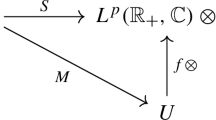Abstract
The problem of approximating Hankel operators of finite or infinite rank by lower-rank Hankel operators is considered. For efficiency, truncated Hankel matrices are used as the intermediate step before other existing algorithms such as theCF algorithms are applied to yield the desirable approximants. If the Hankel operator to be approximated is of finite rank, the order of approximation by truncated Hankel operators is obtained. It is also shown that when themths-number is simple, then rational symbols of the best rank-m Hankel approximants of thenth truncated Hankel matrices converge uniformly to the corresponding rational symbol of the best rank-m Hankel approximant of the original Hankel operator asn tends to infinity.
Similar content being viewed by others
References
[AAK] V. M. Adamjan, D. Z. Arov, and M. G. Krein, Analytic properties of Schmidt pairs for a Hankel operator and the generalized Schur-Takagi problem,Math. USSR-Sb.,15 (1971), 31–73.
[G1] F. R. Gantmacher,Theory of Matrices, 2nd edn., Nauka, Moscow, 1966; English transl. of 1st edn., Chelsea, New York, 1959.
[G2] K. Glover, All optimal Hankel-norm approximations of linear multivariable systems and theirL ∞-error bounds,Internat. J. Control,39 (1984), 1115–1193.
[GCP] K. Glover, R. F. Curtain, and J. R. Partington, Realization and approximation of linear infinite-dimensional systems with error bounds,SIAM J. Control Optim.,26 (1988), 863–898.
[GK] I. C. Gohberg, and M. G. Krein,Introduction to the Theory of Linear Nonselfadjoint Operators in Hilbert Space, Nauka, Moscow, 1965; English transl., Translations of Mathematical Monographs, Vol. 18, American Mathematical Society, Providence, RI, 1969.
[GST] M. H. Gutknecht, J. O. Smith, and L. N. Trefethen, The Carathéodory-Fejér (CF) method for recursive digital filter design,IEEE Trans. Acoust. Speech Signal Process.,31 (1983), 1417–1426.
[H] P. Hartman, On completely continuous Hankel matrices,Proc. Amer. Math. Soc.,9 (1958), 862–866.
[HTG] E. Hayashi, L. N. Trefethen, and M. H. Gutknecht, The CF table,Constr. Approx.,6 (1990), 195–223.
[K1] Y. Katznelson,An Introduction to Harmonic Analysis, Dover Publications, New York, 1976.
[K2] S. Y. Kung, Optimal Hankel-norm model reductions: Scalar systems,Proceedings of the 1980 Joint Automatic Control Conference, Vol. 2, San Francisco, CA, paper FA8-D.
[N] Z. Nehari, On bounded bilinear forms,Ann. of Math.,65 (1957), 153–162.
[PS] L. Pernebo and L. M. Silverman, Model reduction via balanced state-space representation,IEEE Trans. Automat. Control,27 (1982), 382–387.
Author information
Authors and Affiliations
Additional information
Supported by SDIO/IST managed by the U.S. Army under Contract No. DAAL03-87-K-0025 and also supported by the National Science Foundation under Grant No. DMS 8602337.
Supported by SDIO/IST managed by the U.S. Army under Contract No. DAAL03-87-K-0025.
Supported by the National Science Foundation under Grant No. DMS 8602337.
Rights and permissions
About this article
Cite this article
Chui, C.K., Li, X. & Ward, J.D. System reduction via truncated Hankel matrices. Math. Control Signal Systems 4, 161–175 (1991). https://doi.org/10.1007/BF02551264
Received:
Revised:
Issue Date:
DOI: https://doi.org/10.1007/BF02551264



